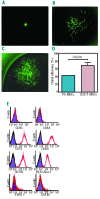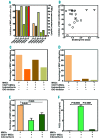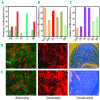Clonal analysis of multipotent stromal cells derived from CD271+ bone marrow mononuclear cells: functional heterogeneity and different mechanisms of allosuppression
- PMID: 23975178
- PMCID: PMC3789467
- DOI: 10.3324/haematol.2013.092700
Clonal analysis of multipotent stromal cells derived from CD271+ bone marrow mononuclear cells: functional heterogeneity and different mechanisms of allosuppression
Abstract
Previous reports demonstrated a relationship between proliferation potential and trilineage differentiation in mesenchymal stromal cell-derived clones generated using plastic adherence (PA-MSCs). However, there are no reports presenting a clonal analysis of the proliferative potential, differentiation potential and allosuppressive effects of human mesenchymal stromal cell subsets. In this study, we performed a clonal analysis of mesenchymal stromal cells generated from human CD271(+) bone marrow mononuclear cells (CD271-MSCs). After transfection with the gene encoding green fluorescent protein, the cells were single-cell sorted and cultured for 2-4 weeks. A population doubling analysis demonstrated that 25% of CD271-MSC clones are fast-proliferating clones compared to only 10% of PA-MSC clones. Evaluation of the allosuppressive potential demonstrated that 81.8% of CD271-MSC clones were highly allosuppressive compared to only 58% of PA-MSC clones. However, no consistent correlation was observed between allosuppression and proliferative potential. Prostaglandin E2 levels were positively correlated with the allosuppressive activity of individual clones, suggesting that this molecule may be a useful predictive biomarker for the allosuppressive potential of mesenchymal stromal cells. In contrast, inhibitory studies of indoleamine 2,3 dioxygenase indicated that none of the clones used this enzyme to mediate their allosuppressive effect. Differentiation studies revealed the presence of tripotent, bipotent and unipotent CD271-MSC and PA-MSC clones which suppressed the allogeneic reaction to differing extents in vitro. In conclusion, our findings demonstrate differences between CD271-MSCs and PA-MSCs and indicate that neither proliferation potential nor differentiation potential represents a consistent predictive parameter for the immunomodulatory effects of either type of mesenchymal stromal cells.
Figures







Similar articles
-
Mesenchymal stromal cells derived from CD271(+) bone marrow mononuclear cells exert potent allosuppressive properties.Cytotherapy. 2011 Nov;13(10):1193-204. doi: 10.3109/14653249.2011.605118. Epub 2011 Sep 12. Cytotherapy. 2011. PMID: 21905954
-
CD271 antigen defines a subset of multipotent stromal cells with immunosuppressive and lymphohematopoietic engraftment-promoting properties.Haematologica. 2010 Apr;95(4):651-9. doi: 10.3324/haematol.2009.015065. Epub 2010 Feb 23. Haematologica. 2010. PMID: 20179086 Free PMC article.
-
In vitro migration and proliferation ("wound healing") potential of mesenchymal stromal cells generated from human CD271(+) bone marrow mononuclear cells.J Transl Med. 2015 Sep 25;13:315. doi: 10.1186/s12967-015-0676-9. J Transl Med. 2015. PMID: 26407865 Free PMC article.
-
Isolation and characterization of primary bone marrow mesenchymal stromal cells.Ann N Y Acad Sci. 2016 Apr;1370(1):109-18. doi: 10.1111/nyas.13102. Ann N Y Acad Sci. 2016. PMID: 27270495 Review.
-
The origins of mesenchymal stromal cell heterogeneity.Stem Cell Rev Rep. 2011 Sep;7(3):560-8. doi: 10.1007/s12015-011-9229-7. Stem Cell Rev Rep. 2011. PMID: 21437576 Review.
Cited by
-
Heterogeneity of mesenchymal stem cells in cartilage regeneration: from characterization to application.NPJ Regen Med. 2021 Mar 19;6(1):14. doi: 10.1038/s41536-021-00122-6. NPJ Regen Med. 2021. PMID: 33741999 Free PMC article. Review.
-
The influence of cell source on the senescence of human mesenchymal stem/stromal cells.Hum Cell. 2025 Apr 12;38(3):87. doi: 10.1007/s13577-025-01213-y. Hum Cell. 2025. PMID: 40221541 Review.
-
Mechanisms of Immune Suppression Utilized by Canine Adipose and Bone Marrow-Derived Mesenchymal Stem Cells.Stem Cells Dev. 2017 Mar 1;26(5):374-389. doi: 10.1089/scd.2016.0207. Epub 2017 Jan 24. Stem Cells Dev. 2017. PMID: 27881051 Free PMC article.
-
Adipose Tissue-Derived Mesenchymal Stem Cells Have a Heterogenic Cytokine Secretion Profile.Stem Cells Int. 2017;2017:4960831. doi: 10.1155/2017/4960831. Epub 2017 May 31. Stem Cells Int. 2017. PMID: 28642794 Free PMC article.
-
p75NTR optimizes the osteogenic potential of human periodontal ligament stem cells by up-regulating α1 integrin expression.J Cell Mol Med. 2020 Jul;24(13):7563-7575. doi: 10.1111/jcmm.15390. Epub 2020 May 18. J Cell Mol Med. 2020. PMID: 32424966 Free PMC article.
References
-
- Phinney DG. Functional heterogeneity of mesenchymal stem cells: implications for cell therapy. J Cell Biochem. 2012;113(9):2806–12 - PubMed
-
- Muraglia A, Cancedda R, Quarto R. Clonal mesenchymal progenitors from human bone marrow differentiate in vitro according to a hierarchical model. J Cell Sci. 2000;113( Pt 7):1161–6 - PubMed
-
- Russell KC, Phinney DG, Lacey MR, Barrilleaux BL, Meyertholen KE, O’Connor KC. In vitro high-capacity assay to quantify the clonal heterogeneity in trilineage potential of mesenchymal stem cells reveals a complex hierarchy of lineage commitment. Stem Cells. 2010;28(4):788–98 - PubMed
-
- Okamoto T, Aoyama T, Nakayama T, Nakamata T, Hosaka T, Nishijo K, et al. Clonal heterogeneity in differentiation potential of immortalized human mesenchymal stem cells. Biochem Biophys Res Commun. 2002;295(2):354–61 - PubMed
Publication types
MeSH terms
Substances
LinkOut - more resources
Full Text Sources
Other Literature Sources

